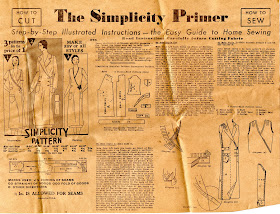About 1930.
I've seen the word "utility" used to describe clothing as early as 1898, but the term gets its last big hurrah during World War II, particularly in Britain, where utility clothing was endorsed by the government. I suspect the whole idea of utility clothing carried such emotionally difficult connotations by the time the war was over that nobody ever wanted to hear the term again, and I don't think anybody has.
Thus, a utility robe is serviceable and economical to make and maintain. Simplicity's three-in-one strategy serves them well with this pattern. Here is the chirpy description from the instruction sheet:
Three distinctly different utility garments for 'round the house wear may be made from this one SIMPLICITY hand cut pattern.
Style #1 With its feminine frill is a dainty, useful morning apron or house-frock.
Style #2 A careful choice of fabrics creates a mannish, tailored, lounging robe.
Style #3 The Hooverette is the ideal garment for the practical side of housekeeping.
This fairly brief passage gives us a lot of information. First, these garments were for household wear only, although I suspect it was acceptable to go out in the back yard to hang some laundry or to nip on down to the end of the driveway to leave a letter in the mailbox. Also, even for garments worn only at home, a desire for femininity is recognized (or perhaps just marketed to.) Lastly, a morning apron and a Hooverette were either perceived to have different functions, or met differing ideas of acceptable or desirable dress. (For example, my grandmother wore house coats, I wear robes, they look pretty much identical to me, but I would probably shop for a robe pattern rather than one for a house coat.)


I wish I lived in times past when ladies wore house-frocks... sigh.
ReplyDeleteI once engaged my father in conversation about his mother's habits of dress. He said first of all, that she put on her stockings very first thing.... "maybe even before she got out of bed" yipes. In the very early morning, she would wear a housecoat over her nightwear, but she would change into a housedress quite early (usually "flowered and with some type of trimming.") Early, meaning typically before the rest of the family was up and about. If she had to go out to run errands or go visiting, she usually did that in the afternoon, and would change into another dress or suit. Always a hat and gloves were worn if she left the house. My grandmother was a lady of Boston, and she passed away in the late 1950's. Like I said... I wish I lived back then☺
I'm just old enough to remember my mother putting on a hat and gloves when going shopping downtown, and she remembers her mother always changing into an afternoon dress after having finished the morning's housework and had lunch.
ReplyDeleteOne of the few good things about the present age is that there is so much room for personal expression that probably nobody will think twice if you sally out in a hat and gloves with shoes and handbags to match.
I wish I could get hold of that robe pattern - VERY wearable, both as a dressing gown (how nice not to have a tie that makes you look like a sack of potatoes) and as a dress. This looks very much like Diana von Furstenberg's wrap dresses - possibly what she based them on?
ReplyDeleteFascinating social history - I love your blog! Keep 'em coming.
Susie - I think you're spot on in linking the wrap style to DVF's iconic wrap dress. This point was also raised by Latter Day Flapper, who posts here regularly, and she cited the book The House Dress: A Story of Eroticism and Fashion, by Elda Danese. (I have it on my Amazon wish list, but haven't read it yet.)
ReplyDeleteIt's not so surprising that these dresses were not meant to be worn outside of the house (or backyard, or porch, which is why you sometimes see them referred to as "porch" dresses). Nearly everything a middle-class home needed was brought to the door; Tony the fruit and vegetable man (in the 1960's in suburban Detroit we still had a Tony), Mike from the wetwash laundry picked up and delivered, even the drugstore and the grocery store had a teenaged boy on a bike who rode over with your phoned-in order.
ReplyDeleteSerious shopping at the department stores downtown mean hat, gloves, stockings, and a suit or tailored dress.
And of course a stop at the ladies' tearooms for sustenance before catching the streetcar home.
That's a good point about services coming to the home. And remember alleys where the deliveries were made?
ReplyDeleteThere are a couple of late '20s McCall patterns for porch dresses that I covet, and I have a 1914 issue of Priscilla Magazine that has a pattern for porch sweater that I've got on my life list of things to knit.
I actually really like this one & I am entranced by the idea of a housedress. I've been toying with the idea of making myself one for the longest time. I find it so hard to be motivated to clean, fold, etc. in my usual uniform of schlumpy jeans & a T shirt!
ReplyDelete